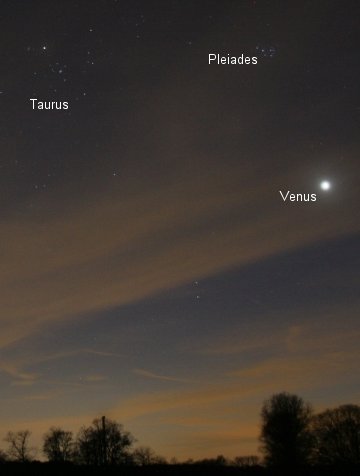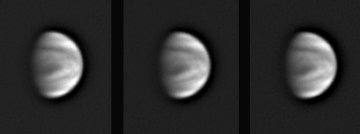 Did you miss last night's auroras? Next time get a wake-up call from Spaceweather PHONE.
Did you miss last night's auroras? Next time get a wake-up call from Spaceweather PHONE.
AURORA WATCH: Sky watchers from Scandinavia to Alaska should be alert for auroras on April 10th. A solar wind stream is due to hit Earth, and the impact could cause high-latitude geomagnetic storms.
VENUS AND THE PLEIADES: The Goddess of Love is about to pay a visit to the Seven Sisters--or as an astronomer would say, Venus is moving into conjunction with the Pleiades. The planet and the star cluster will be side-by-side after dark on Wednesday, April 11th: finder chart.

Photo details: Canon EOS 20D, 135 mm, 100 ASA
Günther Strauch of Borken, Germany, snapped this picture of Venus approaching the Pleiades on April 4th. Venus was so bright it beamed right through the clouds, forming a lovely halo: image. "Very nice," he says. And the view will only improve in the nights ahead
What are the Pleiades? A cluster of baby stars. They formed barely 100 million years ago, during the age of dinosaurs on Earth, from a collapsing cloud of interstellar gas. The biggest and brightest are blue-white and about five times wider than our own sun. Because the brightest stars of the cluster form a little dipper shape in the sky, the Pleiades are often mistaken for the Little Dipper--but the two are not the same. The Little Dipper is another name for the constellation Ursa Minor, while the Pleiades are part of the constellation Taurus. Scanning the Pleiades with binoculars reveals dozens of stars invisible to the unaided eye. It's very pretty, so take a look!
MYSTERY IN THE CLOUDS: Seen through an ordinary backyard telescope, Venus seems bland. It's a featureless, cloud-covered orb about as interesting as a billiard ball. But if that same telescope is fitted with an ultraviolet filter, a mystery reveals itself. Venus' clouds are cross-crossed with fast-moving dark bands, shown here in a series of March 30th photos from Ed Lomeli of Sacramento, California:

Photo details: Celestron 9-inch telescope, DMK 21BF04, UV pass filter
The bands are the mystery. Some unknown substance within them strongly absorbs UV light, accounting for almost half of the solar energy trapped by Venus. Whatever is in there, it plays a big role in maintaining Venus' hellish climate; the average temperature on the surface is about 460° Celsius. Astronomers have been studying the bands since Mariner 10 spotted them in the 1970s, but decades later no one knows the identity of the "UV absorbers." Candidates range from gaseous chlorine and sulfur compounds to alien life using UV radiation as a source of energy. Maybe Venus Express, a European spacecraft orbiting Venus now, will solve the puzzle.
To photograph the bands, Lomelli used a 9-inch Celestron telescope, a 640x480 monochrome ccd camera, and a 1.25-inch Schuler photometric UV pass filter. "I also have the Baader UV pass filter, but the Schuler is a better performer," he advises.

